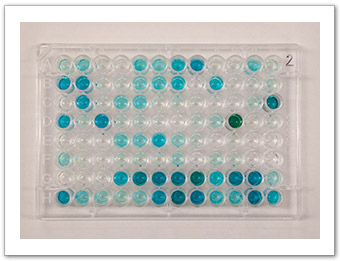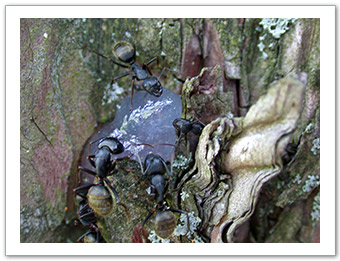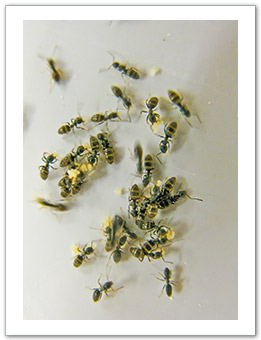Current Research Projects
Use of immunomarking techniques to study nutrient distribution, foraging ecology, and spatial colony structure in ants
 ^An ELISA plate showing positive samples (in blue)
^An ELISA plate showing positive samples (in blue)
We use a combination of laboratory and field tests to investigate the foraging ecology in urban ants at ecological scales ranging from the population to the community. Specific research topics include the effect of colony spatial structure on food distribution, trophallaxis and feeding relationships within colonies, food preferences, and tracking trophic links in predator-prey interactions. To track the movement of food we use protein marking (rabbit immunoglobin) coupled with the highly sensitive DAS-ELISA (double antibody sandwich enzyme-linked immunosorbent assay). The primary goal of these efforts is to understand the mechanisms and pathways of food distribution in ant colonies as dictated by various social and ecological factors. In addition, the research is designed to provide a framework for designing innovative integrated approaches (IPM) for the management of pest ants.
Colony and population genetic structure in the black carpenter ant, Camponotus pennsylvanicus using microsatellite markers
 ^Black carpenter ant workers feeding on a sugar bait
^Black carpenter ant workers feeding on a sugar bait
Camponotus is one of the largest ant genera, yet virtually no information exists on the spatial, social, and genetic structure of Camponotus colonies. The black carpenter ant, Camponotus pennsylvanicus, is the most abundant species it the United States and is ecologically and economically important. However, their cryptic nesting and foraging habits have hindered our understanding of many important features of their life history and population dynamics. To address this gap we are using molecular genetic markers - microsatellites and mtDNA - to generate the fine-scale genetic structure of colonies and populations of C. pennsylvanicus and to characterize the sociogenetic structure of colonies in different habitats.
Evolutionary shifts associated with the transition of native ants into invasive urban pests
 ^Odorous house ant workers with brood
^Odorous house ant workers with brood
Human modification of the environment inadvertently creates perfect habitat for a wide range of urban pests. As a result, some species adapt to take advantage of the changing landscape. The odorous house ant (OHA), Tapinoma sessile, is a native ant species that is very opportunistic and highly variable in its social structure. In its natural habitat, OHA is a low-key species comprised of small monogynous and monodomous colonies. In invaded urban areas, OHA exhibits extreme polygyny and polydomy and becomes a dominant invasive pest. We are using behavioral, genetic, and ecological approaches to understand the evolutionary forces driving this remarkable transition. Specific research questions include: (1) the effect of environmental factors on OHA colony size and distribution, (2) the effect of OHA supercolonies on other native ant species, and (3) changes in life history traits and colony sociogenetic structure following transition to supercolonies.
The biogeography of invasive termites under climate change
 ^Colony of eastern subterranean termites, Reticulitermes flavipes
^Colony of eastern subterranean termites, Reticulitermes flavipes
The spread of exotic species, climate change, and urbanization are among the most serious global environmental threats. Worldwide, invasive termites are significant economic pests causing damage to human-made structures and wood in service. Several termite species are considered invasive and have spread beyond their native ranges, often with significant economic consequences. We use predictive species distribution modeling (SDMs) to provide a global risk assessment for the world’s most invasive termites. A current project is focused on analyzing the global risk for invasive termites under different scenarios of climate change. Areas suitable for invasive termite are modelled both currently and with predicted climate change. Our goal is to identify areas with the highest risk of invasions and to implement proactive management responses in the case of invasions. Results show that several termite species are expected to significantly increase in their global distribution.


